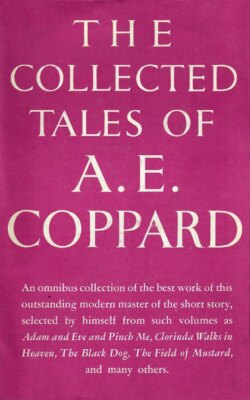Читать книгу The Collected Tales of A. E. Coppard - A. E. (Alfred Edgar) Coppard - Страница 2
FOREWORD
ОглавлениеIn preparing this American omnibus collection of my tales I debated whether to risk saying one or two things about them—and myself. For there are dangers either way. Twenty years ago my Collected Poems were published by Mr. Knopf and in the introduction I committed the indiscretion of stating that I had nothing much to say about my poems except that I liked them myself. This unbearable effrontery annoyed some reviewers; you might truly have thought I had tried to sell the American public a lot of junk, which I now immodestly declare was then, and still is, very far from being my opinion.
So now about these tales: I refrain from owning that I like them myself merely as a precautionary measure, justifiable on the grounds of previous experience and present expedience, and not as an indication of my regard for them one way or the other. My blatant humility is urging me not to leave it at that, but there are just two things I really must say about short stories in general and their principles of manufacture. First, I want to crush the assumption that the short story and the novel are manifestations of one principle of fiction, differentiated merely by size, that the novel is inherently and naturally the substantial and therefore the important piece of work, the bale of tweed—you may suppose—out of which your golfer gets his plus-four suit, the short story being merely a remnant, the rag or two left over to make the caddie a cap. In fact the relationship of the short story to the novel amounts to nothing at all. The novel is a distinct form of art having a pedigree and practice of hardly more than a couple of hundred years; the short story, so far from being its offspring, is an ancient art originating in the folk tale, which was a thing of joy even before writing, not to mention printing, was invented. Put the beginning of English printing in the last quarter of the fifteenth century and you light on a date when the folk tale lost its oral or spoken form and issued as a printed short story. Moreover, it was only through that same device of printing that the novel became even a possibility; it did not materialize until the eighteenth century, its forerunners being Pilgrim’s Progress and Gulliver’s Travels.
The folk tale ministered to an apparently inborn and universal desire to hear tales, and it is my feeling that the closer the modern short story conforms to that ancient tradition of being spoken to you, rather than being read at you, the more acceptable it becomes. One of the earliest delights of childhood is to be told a tale, and the queer pleasure does not lessen or leave us until we ourselves are left in the grave. Cut off a person from all contact with tales and he will assuredly begin to invent some—probably about himself. I don’t know why this is, or what is the curious compulsion that urges some to take to the job of telling the tale, that unconscionable lying which is styled the Art of Fiction, but for good or ill I seem to have been that sort of liar. It has been a pleasant business for me, and I hope it will not be too bad for those about to receive these fabrications.
The second principle I would like to urge is that unity, verisimilitude, and completeness of contour are best obtained by plotting your story through the mind or consciousness of only one of your characters, a process that I used to think might be the secret hinted at in Henry James’s tale “The Figure in the Carpet.”
Of course one does not adhere to literary principles any more than one does to political or moral ones—we accept them for guidance, not for use in dictatorship. As long as mine served and were not too difficult to embody, I was virtuous; whenever they became irksome or incurred some loss of interest, I took the primrose path and hoped for the best.
A. E. Coppard.
